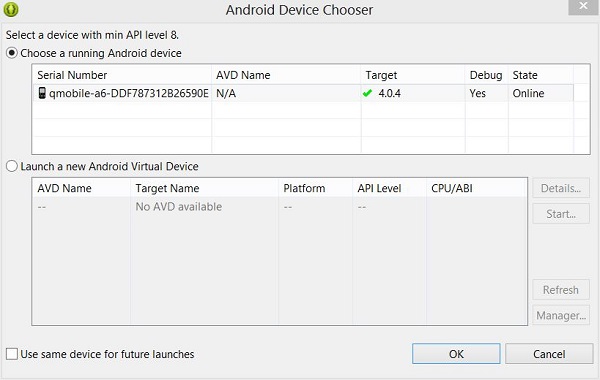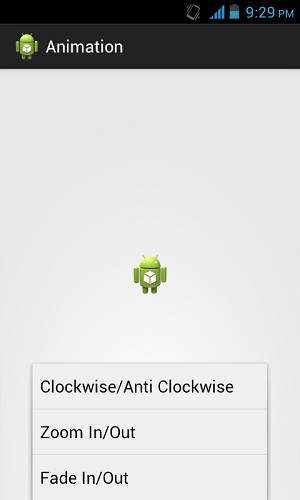Hi developers,
Now in want to give you tutorial about animations
I get this tutorial from TutorialPoints
And thanks a lot to TutorialPoints
I get this tutorial from TutorialPoints
Tween Animation
Tween Animation takes some parameters such as start value , end value, size , time duration , rotation angle e.t.c and perform the required animation on that object. It can be applied to any type of object. So in order to use this , android has povided us a class called Animation.
In order to perform animation in android , we are going to call a static function loadAnimation() of the class AnimationUtils. We are going to recieve the result in an instance of Animation Object. Its syntax is as follows:
Animation animation = AnimationUtils.loadAnimation(getApplicationContext(), R.anim.myanimation);
Note the second parameter. It is the name of the our animation xml file. You have to create a new folder called anim under res directory and make an xml file under anim folder.
In order to apply this animation to an object , we will just call the startAnimation() method of the object. Its syntax is:
ImageView image1 = (ImageView)findViewById(R.id.imageView1); image.startAnimation(animation);
Zoom in animation
In order to perform a zoom in animation , create an XML file under anim folder under res directory and put this code in the file.
<set xmlns:android="http://schemas.android.com/apk/res/android">
<scale xmlns:android="http://schemas.android.com/apk/res/android"
android:fromXScale="0.5"
android:toXScale="3.0"
android:fromYScale="0.5"
android:toYScale="3.0"
android:duration="5000"
android:pivotX="50%"
android:pivotY="50%" >
</scale>
</set>
The parameter fromXScale and fromYScale defines the start point and the parameters toXScale andtoYScale defines the end point. The duration defines the time of animation and the pivotX,pivotYdefines the center from where the animation would start.
Here is the modified code of src/com.example.animation/MainActivity.java.
package com.example.animation;
import com.example.animation.R;
import android.os.Bundle;
import android.app.Activity;
import android.view.Menu;
import android.view.MenuItem;
import android.view.animation.Animation;
import android.view.animation.AnimationUtils;
import android.widget.ImageView;
public class MainActivity extends Activity {
@Override
protected void onCreate(Bundle savedInstanceState) {
super.onCreate(savedInstanceState);
setContentView(R.layout.activity_main);
}
@Override
public boolean onCreateOptionsMenu(Menu menu) {
// Inflate the menu; this adds items to the action bar if it is present.
getMenuInflater().inflate(R.menu.main, menu);
return true;
}
public boolean onOptionsItemSelected(MenuItem item)
{
super.onOptionsItemSelected(item);
switch(item.getItemId())
{
case R.id.zoomInOut:
ImageView image = (ImageView)findViewById(R.id.imageView1);
Animation animation = AnimationUtils.loadAnimation(getApplicationContext(), R.anim.myanimation);
image.startAnimation(animation);
return true;
case R.id.rotate360:
ImageView image1 = (ImageView)findViewById(R.id.imageView1);
Animation animation1 = AnimationUtils.loadAnimation(getApplicationContext(), R.anim.clockwise);
image1.startAnimation(animation1);
return true;
case R.id.fadeInOut:
ImageView image2 = (ImageView)findViewById(R.id.imageView1);
Animation animation2 = AnimationUtils.loadAnimation(getApplicationContext(), R.anim.fade);
image2.startAnimation(animation2);
return true;
}
return false;
}
}
Here is the modified code of res/layout/activity_main.xml.
<RelativeLayout xmlns:android="http://schemas.android.com/apk/res/android"
xmlns:tools="http://schemas.android.com/tools"
android:layout_width="match_parent"
android:layout_height="match_parent"
android:gravity="top"
android:paddingBottom="@dimen/activity_vertical_margin"
android:paddingLeft="@dimen/activity_horizontal_margin"
android:paddingRight="@dimen/activity_horizontal_margin"
android:paddingTop="@dimen/activity_vertical_margin"
tools:context=".MainActivity" >
<ImageView
android:id="@+id/imageView1"
android:layout_width="wrap_content"
android:layout_height="wrap_content"
android:layout_alignParentTop="true"
android:layout_centerHorizontal="true"
android:layout_marginTop="179dp"
android:src="@drawable/ic_launcher" />
</RelativeLayout>
Here is the code of res/anim/myanimation.xml.
<?xml version="1.0" encoding="utf-8"?>
<set xmlns:android="http://schemas.android.com/apk/res/android">
<scale xmlns:android="http://schemas.android.com/apk/res/android"
android:fromXScale="0.5"
android:toXScale="3.0"
android:fromYScale="0.5"
android:toYScale="3.0"
android:duration="5000"
android:pivotX="50%"
android:pivotY="50%" >
</scale>
<scale xmlns:android="http://schemas.android.com/apk/res/android"
android:startOffset="5000"
android:fromXScale="3.0"
android:toXScale="0.5"
android:fromYScale="3.0"
android:toYScale="0.5"
android:duration="5000"
android:pivotX="50%"
android:pivotY="50%" >
</scale>
</set>
Here is the code of res/anim/clockwise.xml.
<?xml version="1.0" encoding="utf-8"?>
<set xmlns:android="http://schemas.android.com/apk/res/android">
<rotate xmlns:android="http://schemas.android.com/apk/res/android"
android:fromDegrees="0"
android:toDegrees="360"
android:pivotX="50%"
android:pivotY="50%"
android:duration="5000" >
</rotate>
<rotate xmlns:android="http://schemas.android.com/apk/res/android"
android:startOffset="5000"
android:fromDegrees="360"
android:toDegrees="0"
android:pivotX="50%"
android:pivotY="50%"
android:duration="5000" >
</rotate>
</set>
Here is the code of res/anim/fade.xml.
<?xml version="1.0" encoding="utf-8"?>
<set xmlns:android="http://schemas.android.com/apk/res/android"
android:interpolator="@android:anim/accelerate_interpolator" >
<alpha
android:fromAlpha="0"
android:toAlpha="1"
android:duration="2000" >
</alpha>
<alpha
android:startOffset="2000"
android:fromAlpha="1"
android:toAlpha="0"
android:duration="2000" >
</alpha>
</set>
Here is the modified code of res/menu/main.xml.
<menu xmlns:android="http://schemas.android.com/apk/res/android" >
<item
android:id="@+id/rotate360"
android:orderInCategory="100"
android:showAsAction="never"
android:title="@string/rotate_String"/>
<item
android:id="@+id/zoomInOut"
android:orderInCategory="100"
android:title="@string/zoom_In_Out"/>
<item
android:id="@+id/fadeInOut"
android:orderInCategory="100"
android:title="@string/fade_String"/>
</menu>
Here is the modified code of res/values/string.xml.
<?xml version="1.0" encoding="utf-8"?> <resources> <string name="app_name">Animation</string> <string name="action_settings">Settings</string> <string name="hello_world">Hello world!</string> <string name="zoom_In_Out">Zoom In/Out</string> <string name="rotate_String">Clockwise/Anti Clockwise</string> <string name="fade_String">Fade In/Out</string> </resources>
Here is the default code of AndroidManifest.xml.
<?xml version="1.0" encoding="utf-8"?>
<manifest xmlns:android="http://schemas.android.com/apk/res/android"
package="com.example.animation"
android:versionCode="1"
android:versionName="1.0" >
<uses-sdk
android:minSdkVersion="8"
android:targetSdkVersion="17" />
<application
android:allowBackup="true"
android:icon="@drawable/ic_launcher"
android:label="@string/app_name"
android:theme="@style/AppTheme" >
<activity
android:name="com.example.animation.MainActivity"
android:label="@string/app_name" >
<intent-filter>
<action android:name="android.intent.action.MAIN" />
<category android:name="android.intent.category.LAUNCHER" />
</intent-filter>
</activity>
</application>
</manifest>
Let's try to run your Animation application. I assume you have connected your actual Android Mobile device with your computer. To run the app from Eclipse, open one of your project's activity files and click Run  icon from the toolbar. Before starting your application, Eclipse will display following window to select an option where you want to run your Android application.
icon from the toolbar. Before starting your application, Eclipse will display following window to select an option where you want to run your Android application.
 icon from the toolbar. Before starting your application, Eclipse will display following window to select an option where you want to run your Android application.
icon from the toolbar. Before starting your application, Eclipse will display following window to select an option where you want to run your Android application.
Select your mobile device as an option and then check your mobile device which will display following screen:

Now just select the menu from your mobile, and a menu would appear which would be something like this:

Now just select the Zoom in , Zoom out option from menu and an animation would appear which would be something like this:

Now just select the clockwise option from menu and an animation would appear which would be something like this:

Now just select the fade in/out option from menu and an animation would appear which would be something like this:

Note: If you run it in emulator , you may not experience smooth animation effect. You have to run it in your android mobile in order to experience the smooth animation.